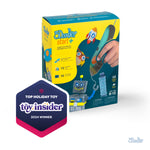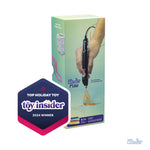Non-Edible Gingerbread House STEAM Challenge
In this activity, students will work in teams of 3-4 to construct a non-edible gingerbread house, combining upcycled materials and 3Doodler plastics. The students will plan, construct, and decorate their “gingerbread house” within materials constraints. The student groups will evaluate their own houses, as well as a second team’s house, on a rubric to determine the “best constructed” house.

KnowledgeStudents havehad an introduction to grade-level appropriate, basic concepts of house construction (foundation, exterior walls, etc.)
A basic working knowledge of the 3Doodler Start pen
had an introduction to grade-level appropriate, basic concepts of house construction (foundation, exterior walls, etc.)
A basic working knowledge of the 3Doodler Start pen
ObjectivesStudents willCreate a rubric listing characteristics of a “well constructed” house
Work together in teams to plan and build non-edible “gingerbread houses”
Use 3Doodler pens to aid in constructing their designed house
Compare and contrast 2 different structures on a rubric
Create a rubric listing characteristics of a “well constructed” house
Work together in teams to plan and build non-edible “gingerbread houses”
Use 3Doodler pens to aid in constructing their designed house
Compare and contrast 2 different structures on a rubric
MaterialsStudents will need3Doodler Start Pens (2 per group of 4 students)
Access to 3Doodler App (for stencils)
Upcycled materials for building, including cardboard, etc.
Scissors, rulers, pencils, etc. for building
3Doodler Start Pens (2 per group of 4 students)
Access to 3Doodler App (for stencils)
Upcycled materials for building, including cardboard, etc.
Scissors, rulers, pencils, etc. for building
Lesson PlanInstructions
Step 1Discuss with the class the requirements of a good house. Students may compare constructing a house to constructing a block structure in that they need a good foundation/base. They should be led to establish criteria for their class developed rubric: required structures, foundation, design, teamwork. Be sure to record a list of the criteria they generate for use on the rubric later.
Step 2Break students into groups. Student groups will now create a “blueprint” sketch for their houses, including the structures established in STEP 1. Blueprints should be colored and as detailed as possible, including a list of materials that students intend to use to construct their houses and justification for using those materials.
Step 3Spend approximately 10-15 minutes introducing the 3Doodler Start pen, including how it works: What is filament? What does it mean to extrude filament? How do you mold the filament once it is extruded? What does the big button do? How do you connect 2 pieces of extruded plastic? Students who have never used a 3Doodler before may want to practice extruding filament and molding a small item. Students should also be introduced to the 3Doodler App.
Step 4Have the students discuss dividing up the work for constructing the house. Remind them they only have 2 pens per group but that all students must help construct. Brainstorm ways that students can be helpful in the construction without using the pens. Students should construct the houses to resemble their blueprints as closely as possible.
The teacher should circulate throughout this process to assist students in using 3Doodlers or in using tools/materials for house construction.


![]() Step 5
Step 5Once houses are constructed, return to the recorded list of criteria to create a rubric for students to use to evaluate their houses. This can be shared with students in the Google Drive or in a manner the teacher feels is appropriate for the skill level of the class.
Step 6Instruct students to evaluate their own team’s house based on the created rubric. When they have evaluated their own houses, discuss their results. If time allows, students may return to their houses to improve them, based on how they feel they performed on their rubrics and re-evaluate their own construction.


 Step 7
Step 7Allow students to evaluate another team’s house construction. Prior to filling out the rubric, teams should be able to interview/question each other on their houses: Who built which parts? How do the houses differ from the blueprints, and why? Each team should fill out the rubric for the other team, including comments, so they can share their evaluations with each other.
Discuss with the class the requirements of a good house. Students may compare constructing a house to constructing a block structure in that they need a good foundation/base. They should be led to establish criteria for their class developed rubric: required structures, foundation, design, teamwork. Be sure to record a list of the criteria they generate for use on the rubric later.
Break students into groups. Student groups will now create a “blueprint” sketch for their houses, including the structures established in STEP 1. Blueprints should be colored and as detailed as possible, including a list of materials that students intend to use to construct their houses and justification for using those materials.
Spend approximately 10-15 minutes introducing the 3Doodler Start pen, including how it works: What is filament? What does it mean to extrude filament? How do you mold the filament once it is extruded? What does the big button do? How do you connect 2 pieces of extruded plastic? Students who have never used a 3Doodler before may want to practice extruding filament and molding a small item. Students should also be introduced to the 3Doodler App.
Have the students discuss dividing up the work for constructing the house. Remind them they only have 2 pens per group but that all students must help construct. Brainstorm ways that students can be helpful in the construction without using the pens. Students should construct the houses to resemble their blueprints as closely as possible.
The teacher should circulate throughout this process to assist students in using 3Doodlers or in using tools/materials for house construction.


Once houses are constructed, return to the recorded list of criteria to create a rubric for students to use to evaluate their houses. This can be shared with students in the Google Drive or in a manner the teacher feels is appropriate for the skill level of the class.
Instruct students to evaluate their own team’s house based on the created rubric. When they have evaluated their own houses, discuss their results. If time allows, students may return to their houses to improve them, based on how they feel they performed on their rubrics and re-evaluate their own construction.



Allow students to evaluate another team’s house construction. Prior to filling out the rubric, teams should be able to interview/question each other on their houses: Who built which parts? How do the houses differ from the blueprints, and why? Each team should fill out the rubric for the other team, including comments, so they can share their evaluations with each other.
Wrap Up
Assessment
Possible Extensions
Resources
Vocabulary
DoodlePad - the plastic sheet used to Doodle with the 3Doodler pen on so that designs can be lifted and moved
Exterior wall - a wall separating the outside environment from the accommodations inside a house
Extrude - The act of plastic being melted and then ejected from the 3Doodler as a steady stream, similar to a thread until stopped.
FILAMENT - 3D printing filament is the thermoplastic feedstock for fused deposition modeling 3D printers.
Foundation - the natural or prepared ground or base on which some structure rests.
Intersection - the place where 2 pieces of cardboard meet
Educational Standards
Select and operate appropriate software to perform a variety of tasks, and recognize that users have different needs and preferences for the technology they use.
Use the 3Doodler app to find a stencil.
Collect and present the same data in various visual formats.
Fill in a spreadsheet with data from a rubric.
Develop a simple sketch, drawing, or physical model to illustrate how the shape of an object helps it function as needed to solve a given problem.
The students will draw sketches of their design ideas to create their non-edible gingerbread houses.
Define a simple design problem reflecting a need or a want that includes a specified criteria for success and constraints on materials, time, or cost.
Students will draw sketches and carry out their design ideas with constraints on materials (using 10 sticks or less of filament).
Students select and use digital tools to plan and manage a design process that considers design constraints and calculated risks.
Use the 3Doodler app to find a stencil.
Students develop, test, and refine prototypes as part of a cyclical design process.
Students build models of a non-edible gingerbread how and can refine the model as they test their designs.
Prepare for and participate effectively in a range of conversations and collaborations with diverse partners, building on others' ideas and expressing their own clearly and persuasively.
Students will be working in teams with 3 other students to design a non-edible gingerbread house from recycled/upcycled materials.
Present information, findings, and supporting evidence such that listeners can follow the line of reasoning and the organization, development, and style are appropriate to task, purpose, and audience.
Students will be evaluating and conferencing with other student teams regarding reasoning behind their house designs.


